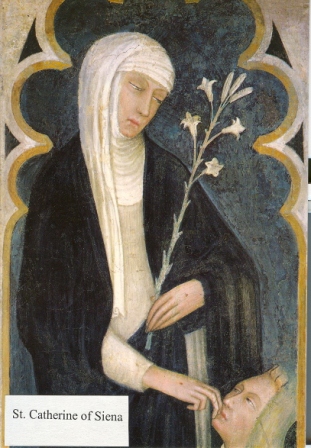

Mural in the Basilica of Santa Maria Sopra Minerva
St. Catherine of Sienna (1347-1380)
The twenty-third child of Jacopo and Lapa Benincasa, Catherine of Siena was a strikingly pleasant and outgoing child, imaginative and idealistic in her devotion. She was also strongly independent, and this independence would be her hallmark.
An Independent Spirit. Catherine grew up very close to San Domenico, a center of Dominican learning and preaching. She spent a great deal of time in the Church and at the age of seven, set her heart on a life centered upon Christ. That was probably fine with her family until she expressed a desire to enter the Dominican Order. Marriage at that time and in that culture was highly valued, and she was told she would marry. Her independence coming to the fore, she cut off her hair to make herself less appealing to any potential suitors. Her father eventually relented and allowed her live as she pleased.
Joining the Mantellate. She joined the Mantellate, women who were affiliated with the Order of St. Dominic. Directed by a prioress, the Mantellate lived in their own homes, wore the habit, and served the needs of the poor and sick. After two years of intensive prayer and meditation, Catherine broke from her practice of extreme solitude and vigorously began to care for the city's marginalized. She served as a nurse in homes and hospitals, looked out for the destitute, and buried the dead. Adopting a Dominican lifestyle that would be seen through the centuries, Catherine based her active life of service to one's neighbor in prayer and contemplation.
In time, her connection with the divine became evident; it drew people to her, increasing her public influence. She began to gather around herself “sons” and “daughters” whom she taught and from whom she learned.
The "Woman Too Much on the Road". Known for her skill in negotiating political conflict, she was instrumental in promoting peace between Rome and Florence. She also became involved in the controversy that split the Church -- not only in half, but into thirds. Because of Catherine's influence, Pope Gregory XI was persuaded to return to Rome.
Upon his death, Gregory was succeeded by Pope Urban VI. Talk of schism was prevalent with many factions opposing Urban's election. Catherine wrote to all who were involved, arguing for loyalty and unity. By this point, she had acquired a reputation as the "woman who was too much on the road." Not wanting to exacerbate this negative view of her work, she indicated she would go to Rome only if the Pope sent explicit orders. Urban did indeed summon her, and she set out for Rome with her "family" of followers. She spent the last two years of her life in Rome, in prayer and negotiation on behalf of Urban the VI and the unity of the Church.
Spiritual Gifts and Writing. While Saint Catherine's letters are a better window to her personality, she is best remembered for her work, The Dialogue. Calling it simply "my book," it is her bequest of her teachings to her followers. Raymond, her spiritual director, noted:
"So about two years before her death, such a clarity of Truth was revealed to her from heaven that Catherine was constrained to spread it abroad by means of writing, asking secretaries to stand ready to take down whatever came from her mouth as soon as they noticed that she had gone into ecstasy. Thus in a short time was composed a book that contains a dialogue between a soul who asks the Lord four questions, and the Lord himself who replies to the soul, enlightening her with many useful truths."
In the last year of her life, Catherine could no longer eat or swallow water. She wrote a few more letters, but most of her time was spent in prayer. Until late February she still managed the mile-long walk to St. Peter's each morning for Mass: she spent the day there in prayer until vespers. On February 26th , she lost the use of her legs and was confined to bed. She died on April 29th in 1380 at the age of 33.
Catherine's life is a concrete example of the Dominican vocation of prayerful action, for it could be said that she was almost never removed from the state of prayer, and yet she accomplished much in the world, more than one would expect given her brief life.
http://www.barry.edu/campusMinistry/dominicans/stCatherineSienna.htm
St. Catherine's impact on her society was so profound that Europe was unable to forget her. Only eighty-one years after her death, she was canonized by Pope Pius II. Even now, Rome recalls her aptitude for unprecedented action. For example, Pope John Paul II honored her "impassioned liveliness" and "freedom of initiative," when he marked the 25th anniversary when she became one of the first women to be named a Doctor of the Church.
http://www.op.org/domcentral/trad/stcather.htm